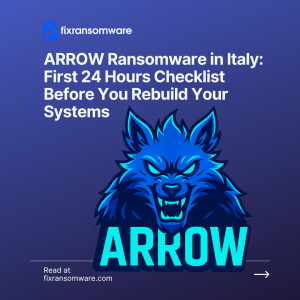When a company in Italy gets hit and everything suddenly goes read-only, the first instinct is often to panic and rebuild. But if you want realistic ARROW ransomware data recovery in Italy, the first 24 hours should not be about reinstalling servers or sending crypto. They should be about containing the attack, preserving evidence, and preparing safe data recovery from ARROW ransomware attacks.
This guide is a practical checklist for IT teams and decision-makers in Italian organisations.
What ARROW Ransomware Does to Your Environment
Once inside your network, ARROW behaves like other modern ransomware families:
- It encrypts shared folders, project files, and finance documents.
- It targets databases and virtual machines so business apps stop working.
- If backups are online 24/7, it may encrypt those too.
- It leaves ransom notes demanding payment in cryptocurrency, often with threats of data leaks.
For companies in Italy, that can mean:
- Disruption of invoicing, payroll, logistics, and customer service.
- Contract risks if you cannot deliver on time.
- Potential regulatory and reputational issues if personal data was accessed.
You cannot undo the initial intrusion, but you can prevent the situation from getting worse.
First 24 Hours: Contain Before You Rebuild
A serious ARROW ransomware data recovery effort always starts with containment, not with “format C:” or buying new servers.
a. Isolate affected systems
- Disconnect infected servers, NAS devices, and workstations from the network.
- Temporarily disable VPN access if remote endpoints might be spreading the attack.
b. Do not delete encrypted data
- Encrypted files typically no longer contain active malicious code.
- These files are exactly what specialists will need for any ARROW ransomware data recovery attempt.
c. Hunt for the executables and persistence
- Check for unusual services, scheduled tasks, startup entries, and binaries.
- Stop processes clearly responsible for the encryption, but avoid random “cleanup” that destroys evidence.
d. Preserve evidence
- Keep ransom notes, firewall and VPN logs, endpoint security alerts, and suspicious emails or attachments.
- This material is useful for incident reports and for following guidance from authorities such as CISA’s StopRansomware, which, while US-focused, outlines generally accepted best practices.
Containment is about buying time and preserving options. It is not yet about “fixing everything in one night”.
Planning ARROW Ransomware Data Recovery in Italy
Once the fire is contained, you can start planning ARROW ransomware data recovery in Italy in a structured way.
a. Map what is really affected
- List all servers, NAS, and critical user machines that are encrypted.
- Distinguish between “business-critical” (ERP, accounting, core file servers) and “nice to have”.
b. Evaluate your backups honestly
- Do you have offline, off-site, or immutable backups that ARROW could not reach?
- Test small restores in an isolated environment; never assume backups are fine without proof.
c. Confirm you’re dealing with ARROW
- File extensions, ransom note text, and attacker contact details usually reveal the family.
- Correct identification helps specialists choose the safest approach and avoid destructive guesswork.
d. Avoid random decryptor tools
- Many “free decryptors” on the internet either do not work or damage file structures.
- A bad attempt can turn a recoverable case into permanent loss.
The goal here is not speed at any cost, but maximum data recovery with minimum additional damage.
Why Paying the Ransom Is a High-Risk Shortcut
Paying the ransom might look like the fastest way out, but it is a gamble with poor odds:
- There is no guarantee you will receive a working key.
- Even with a key, decryption can be partial, slow, or corrupt some data.
- Your company may be flagged as a paying target, increasing the chance of future attacks.
- Legal and contractual exposure remains because the breach already happened.
For most organisations, investing in controlled ARROW ransomware data recovery is a better long-term decision than funding the attackers.
Working With a Professional Recovery Service
Many Italian businesses run with small IT teams that are excellent at day-to-day operations but not specialised in deep ransomware repair. That is where a dedicated recovery service helps:
- Sample-based technical assessment
- Provide a limited set of encrypted files and, if possible, their original versions from backup.
- Specialists use these pairs to see whether safe decryption or low-level repair is technically possible.
- Lab-based test recovery
- All experiments are done on copies in an isolated lab, not your only production data.
- Only proven methods are applied to full datasets.
- Business-driven restoration order
- Restore finance, ERP, and critical file servers first, then less essential systems.
- Give management realistic timelines based on evidence, not wishful thinking.
- Hardening before going live again
- Patch exposed services, close unnecessary ports, tighten remote access, and rotate credentials.
- Redesign backup with offline or immutable layers plus regular restore tests.
FixRansomware focuses on complex server, NAS, and database cases, including ARROW and similar families. You can upload small encrypted samples (under 1 MB) through the secure portal at app.fixransomware.com for initial analysis, and share larger datasets via cloud storage when needed.
You cannot change the fact that ARROW ransomware hit your company in Italy, but you can decide whether the next step is panic and blind payment, or a controlled, professional recovery process.


